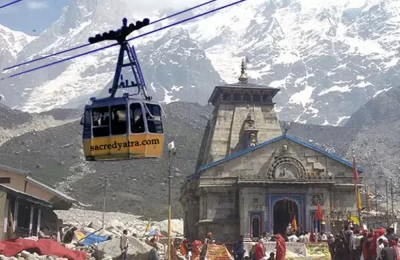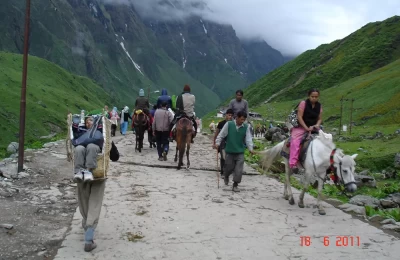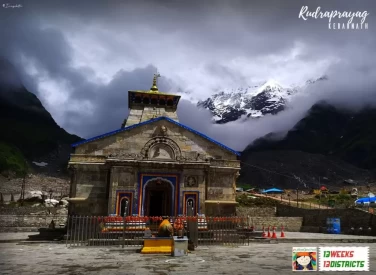Kedarnath to Badrinath

The spiritual journey from Kedarnath to Badrinath winds through a tapestry of spirituality, challenging terrain, and traditional customs, all nestled within the breathtaking peaks of the Himalayas. These revered pilgrimage sites stand as beacons of devotion, drawing seekers from across the globe to embark on the sacred Char Dham Yatra. Kedarnath, dedicated to Lord Shiva, and Badrinath, a shrine to Lord Vishnu, are not merely destinations; they are living sanctuaries that have witnessed centuries of faith, echoing with the footsteps of countless pilgrims who have sought solace and blessings along this divine trail.
The trail from Kedarnath to Badrinath unfolds a saga of spiritual significance, encapsulating the essence of Hindu mythology and the resilience of devotees. As pilgrims traverse this ancient path, they tread in the footsteps of saints and sages, navigating through breathtaking landscapes that inspire awe and humility. Badrinath, revered as the final Dham for darshan in the sacred Char Dhams, which include Yamunotri, Gangotri, Kedarnath, and Badrinath, holds a singular and profound significance. The journey is not only a physical expedition but a soul-stirring odyssey, inviting pilgrims to connect with the divine forces that govern these sacred realms.
How to Travel From Kedarnath to Badrinath
- By Road: The pilgrimage from Kedarnath to Badrinath typically starts with pilgrims trekking or opting for a pony or horse ride from Kedarnath to Sonprayag. From Sonprayag, pilgrims can choose from various transportation options for the road journey to Badrinath, covering approximately 224km in 8 hours. Buses, taxis, and private automobiles are available, providing pilgrims with flexibility in their mode of travel while enjoying the breathtaking views of snow-capped peaks, meandering rivers, and lush green valleys.
- By Helicopter: For those seeking a quicker and more comfortable journey, helicopter services are available to transport pilgrims directly to the temple sites. This option not only saves time but also provides a unique and mesmerizing aerial perspective of the rugged terrain. Covering a distance of 41 km in just 30 minutes, passengers are treated to breathtaking views of the majestic Himalayan peaks, winding rivers, and lush green valleys, creating an unforgettable experience amidst the natural beauty of the region. You can get Helicopter Ride for Kedarnath & Badrinath from our Do Dham Helicopter Package.
Kedarnath to Badrinath : Distances and Itinerary
Distances
The distance between Kedarnath and Badrinath is approximately 224 kilometers by road. However, due to the challenging mountainous terrain, the journey may take a considerable amount of time, and alternative modes of transportation, such as helicopters, are also available for a quicker travel option.
Itinerary:
- Start at Kedarnath: Begin your journey from the holy town of Kedarnath, which lies in Uttarakhand, India's Rudraprayag district, at an elevation of around 3,583 meters (11,755 feet). Seek blessings at the Kedarnath Temple dedicated to Lord Shiva, a major pilgrimage site perched amidst the Garhwal Himalayas.
- Travel to Gaurikund: Departing Kedarnath and traveling 16 kilometers to Gaurikund covers the first leg of the journey. A major pilgrimage site, Gaurikund is the base camp for the journey to Kedarnath.
- Drive to Joshimath: Drive 200 kilometers, passing through beautiful scenery, to reach Joshimath from Gaurikund. Joshimath, a pilgrim town at a lower height, provides a chance to relax before continuing on to Badrinath.
- Visit Badrinath: There is a 42-kilometer travel time in the last area from Joshimath to Badrinath. When you go to the holy Badrinath Temple, which is devoted to Lord Vishnu, you can explore the village of Badrinath, which is situated at a height of roughly 3,100 meters (10,170 feet).
Shortest Route From Kedarnath to Badrinath Via Ukhimath Chopta Gopeshwar Route
The route from Kedarnath to Badrinath via Ukhimath, Chopta, and Gopeshwar covers a distance of approximately 207 kilometers. Pilgrims embarking on the sacred journey from this shortest route can have the opportunity to enrich their spiritual experience by including a visit to the revered Tungnath Temple. Commencing the pilgrimage from Kedarnath, they can progress towards Guptkashi and then Ukhimath.
From Ukhimath, pilgrims can proceed to Chopta, and here, they can take a detour to visit the ancient Tungnath Temple, dedicated to Lord Shiva. After seeking blessings at Tungnath, pilgrims can return to Chopta and continue their journey towards Gopeshwar. Finally, they can conclude their pilgrimage by traveling from Gopeshwar to the sacred town of Badrinath.
How Pilgrims Traveled from Kedarnath to Badrinath in Old Time
In the past, pilgrims would typically trek from Kedarnath to Badrinath on foot, covering a distance of approximately 190 kilometers (118 miles). The journey involves traversing challenging terrain, including mountainous paths and river crossings. Pilgrims would often embark on this arduous trek to seek blessings, perform religious rituals, and immerse themselves in the spiritual ambiance of the Himalayas. Pilgrims would start their journey from Kedarnath, which houses the famous Kedarnath Temple dedicated to Lord Shiva.
The route takes them through picturesque landscapes, dense forests, and several small villages. Along the way, there are also other religious sites, natural wonders, and resting places for pilgrims. While walking was the traditional mode of transportation for pilgrims in the past, today there are alternative means, such as pony rides and helicopter services, that provide a quicker and less physically demanding option for those unable to undertake the challenging trek on foot.



















